|
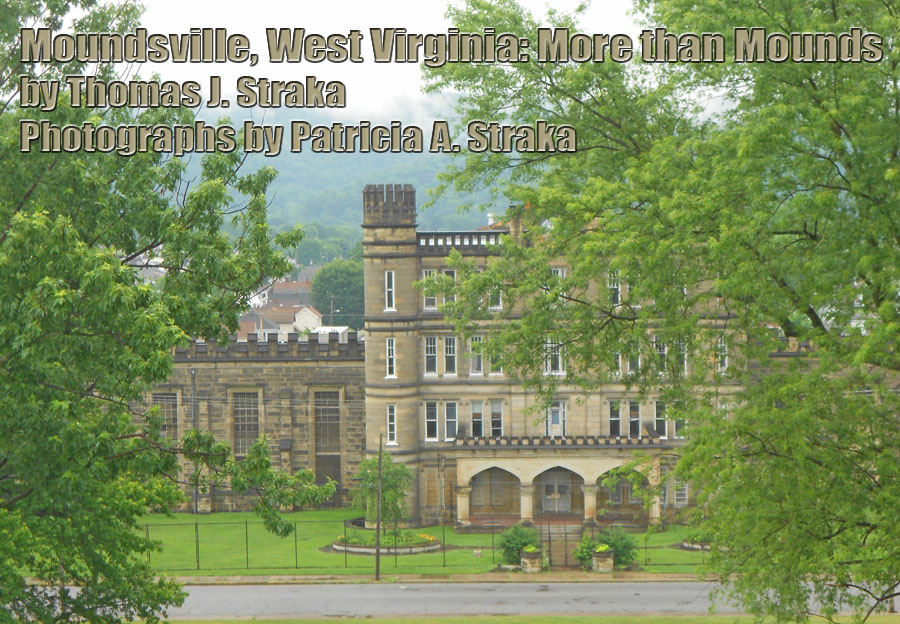
Sometimes you stumble on to an interesting place without even
planning on it.
Moundsville, just south of Wheeling in West Virginia's
panhandle, between Pennsylvania and Ohio, is one of those
places. The name comes from the many Native American mounds in
the area and largest and most prominent one, the Grave Creek
Mound, is in the center of town on the main thoroughfare. A
state historical marker gives the details of the original
dimensions, the moat, and an early tunnel into the mound's
interior.
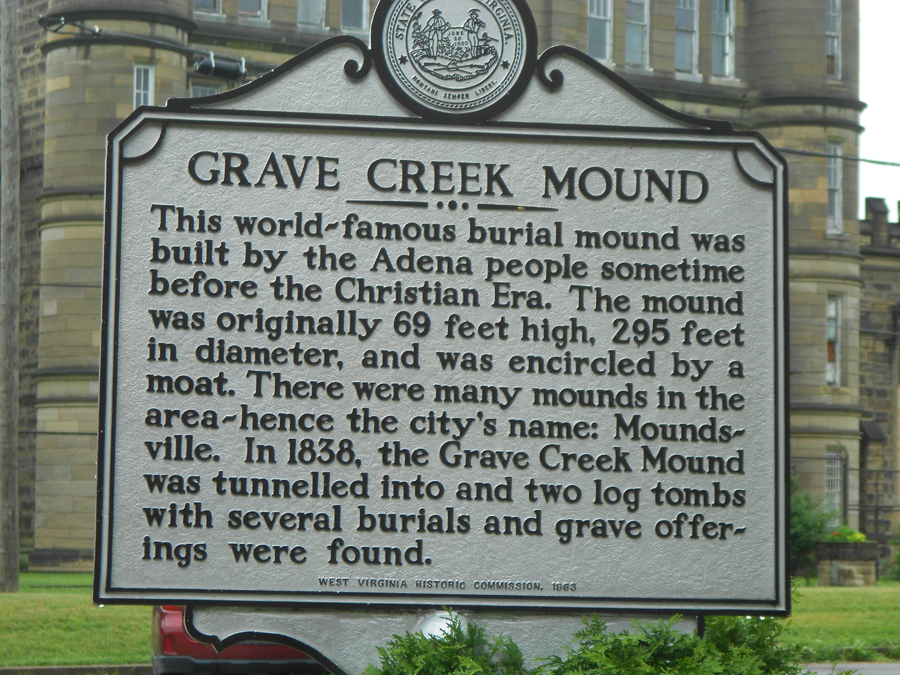 |
| Historical marker gives the
details. |
The Native American tribes built the mounds as ceremonial
centers, burial sites, and elite residences.
Mound building in North America occurred over 5,000
years, from 3500 B.C. to 100 B.C. and was centered on the
Mississippi River Valley, the Great Lakes, and Ohio River
Valley. The Grave
Creek Mound is from the Adena Mound Building Culture that
existed from 1000 B.C. to 100 B.C. They built mounds throughout
the Ohio River Valley.
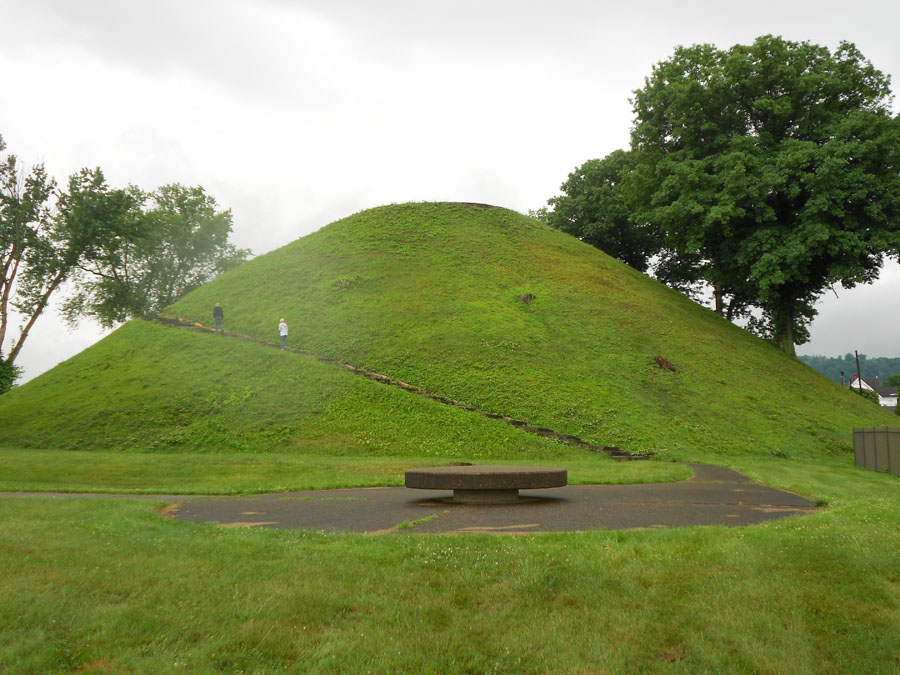 |
| The mound, with two climbers on
the side to show scale. |
This is the largest conical mound in the United States. It is a
burial mound that began with the death of a very important
person, likely a respected leader or a powerful shaman (priest).
Burial would involve an elaborate ceremony and a log
tomb. Tombs included two people and perhaps the second one was a
sacrificial victim. A small mound was built over the tomb and
continuously over the next 20 to 30 years it grew to a height of
27 feet. Then a second high-ranking individual died and a second
tomb was created on top of the first tomb, with mound building
continuing. The process was repeated until the mound reached a
height of nearly 70 feet.
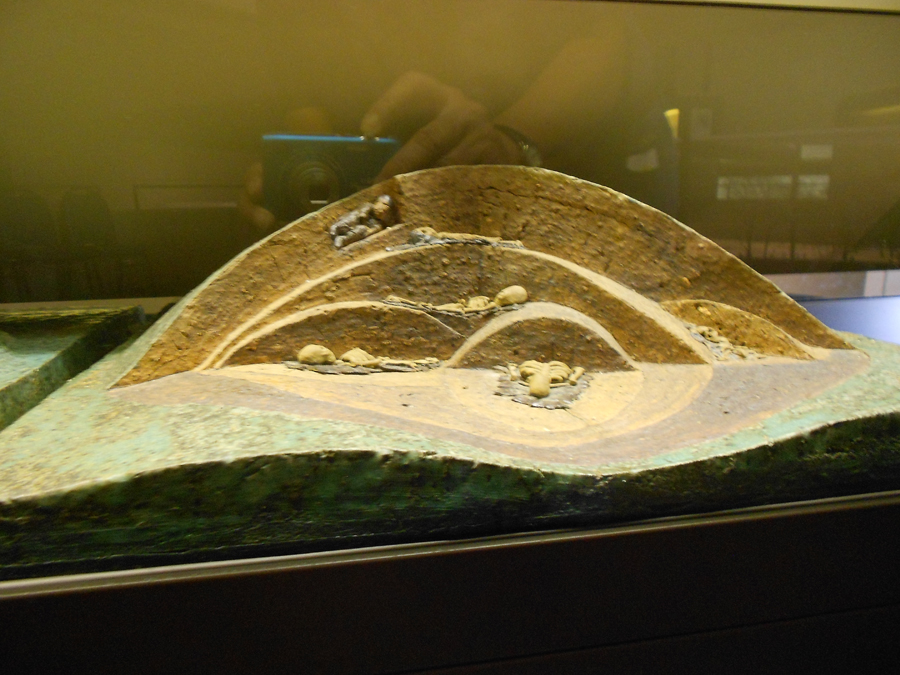 |
| The logistics of mound building. |
The ditch or moat around the mound was due to earth being
removed to build the mound. It was 40 feet wide and five feet
deep. Today the moat is gone. Locals excavated the mound in
1838, digging two horizontal tunnels and a vertical shaft. They
located the burial chambers.
The center chamber was opened to the public for 25 cents
admission. The flat top has served as a saloon, dance platform,
and even held artillery during the Civil War. Next to the mound
is a museum that describes the Adena Culture and the mound
building process. We've
visited many Native American mounds. This is one of the most
accessible and the museum is full of displays that illustrate
exactly how this monumental task was accomplished.
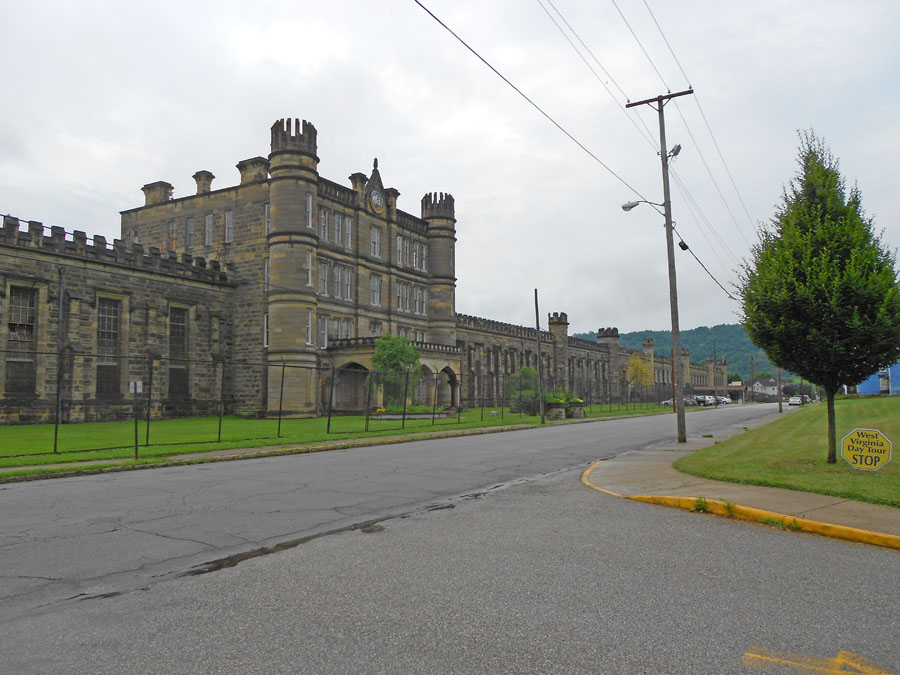 |
| The front of the prison complex,
from the museum. |
The title says "more than mounds." The original intent for this
stop was the mound. Surprisingly, something more interesting and
equally monumental, at least to the author, was the old West
Virginia State Penitentiary right across the street. It is
something out of the movies, literally (Night
of the Hunter in 1955,
Fools' Parade in 1971, and
Out of the Furnace in
2013). It is a commanding stone structure, fashioned in a gothic
architectural style, including castle-like battlements and
turrets. Joliet prison in Illinois served as its model. Think
The Shawshank Redemption, walls
five thick at the bottom, two and a half feet thick at the top,
with a foundation five feet below ground, and turrets at each
corner for guards.
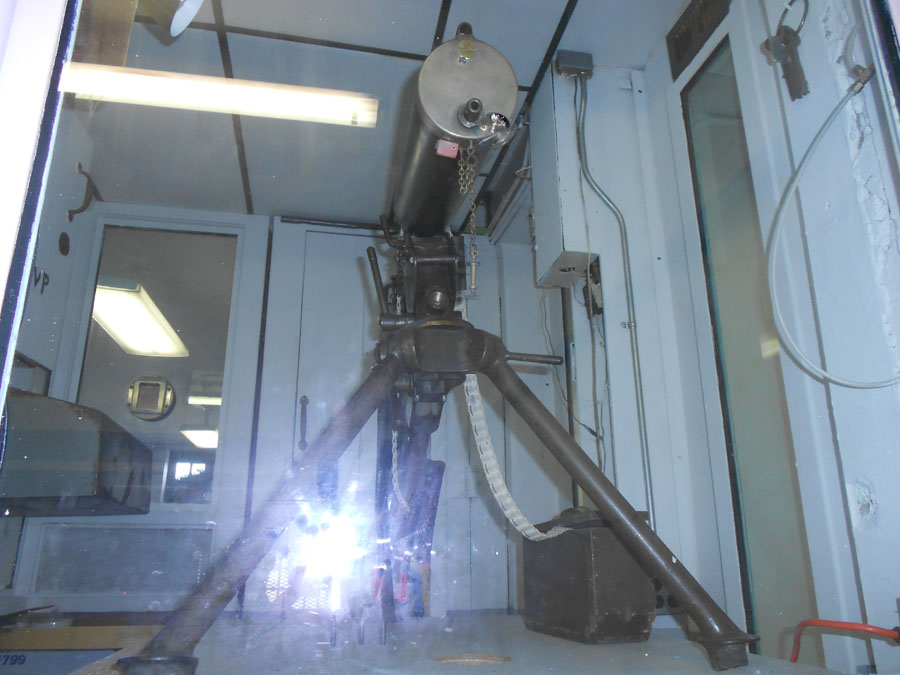 |
|
There are many of the arms and
other equipment used by the guards still in the prison.
This machine gun discouraged escapes and undesirable
behavior.
|
The prison opened in 1876 and was one of West Virginia's first
public buildings.
Cells were small, five by seven feet, but at times held two, or
even three prisoners.
In the mid-1980s the state Supreme Court ruled this was
cruel and unusual punishment.
It took until 1995 to close the prison. Its history
includes many murders, brutal beatings, prison riots, hangings,
and electrocutions.
These even form the basis of a ghost tour business.
The standard guided tour is during the day and takes
about 90 minutes.
The tour starts in the museum/gift shop and displays provide
interesting background on the prison.
There are photographs of executed inmates, equipment
displays, and even a letter from Charles Manson requesting to be
relocated to the former prison (to be near his family).
The museum has an electric chair on display ("Old Sparky")
that was used at the prison.
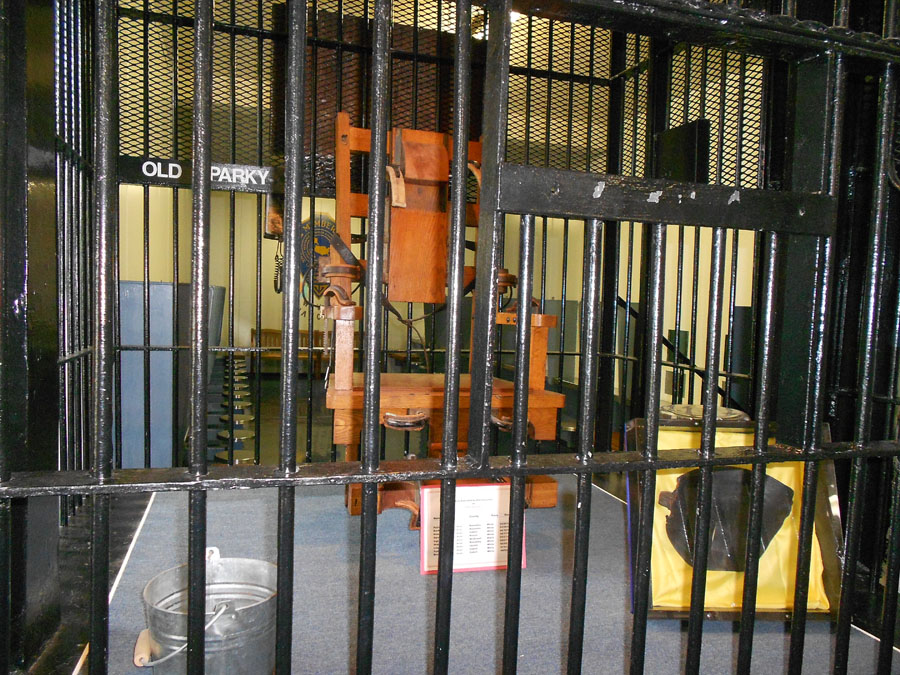 |
| "Old Sparky," the electric chair
built in the prison, responsible for nine
electrocutions. |
The tour starts in the original visitor's area, where visitors
sat on one side and prisoners on the other.
The guide introduces the artwork on the walls that will
be in many areas of the prison. The men had a lot of time on
their hands; some of the artists were quite good, some were not.
Not surprisingly, there many nature scenes, something the men
likely missed. But
the variety of expression goes way beyond nature, especially in
some of the prison cells. The prison has four sections: "The
Alamo", for the meanest and most dangerous prisoners; "New Wall"
for the common not-likely-to-murder-a-guard inmates; "Rat Roll"
for the rats and snitches, those inmates who might have
testified against other inmates or passed information on to the
guards, and who needed special protection; and "Honor Hall" for
the trustees who needed less security and were allowed special
privileges.
Exercise yards were also segregated for obvious reasons (or the
rats and snitches would not last long).
 |
| Notice the protected guard
station, where prisoners were watched from above by
armed guards. |
Probably the most interesting part is simply seeing the cells.
The artwork inside is fascinating and the size (or lack
of size) is hard to imagine without being in a cell. The feel of
the cell block comes right out of a 1930s movie. Visitors are
invited into the cells before the doors are locked in one huge
hydraulic moment.
The door is left locked for a brief moment, but long enough for
some of the visitors to complain they've had enough. It's an
experience I'd only want via a guided tour.
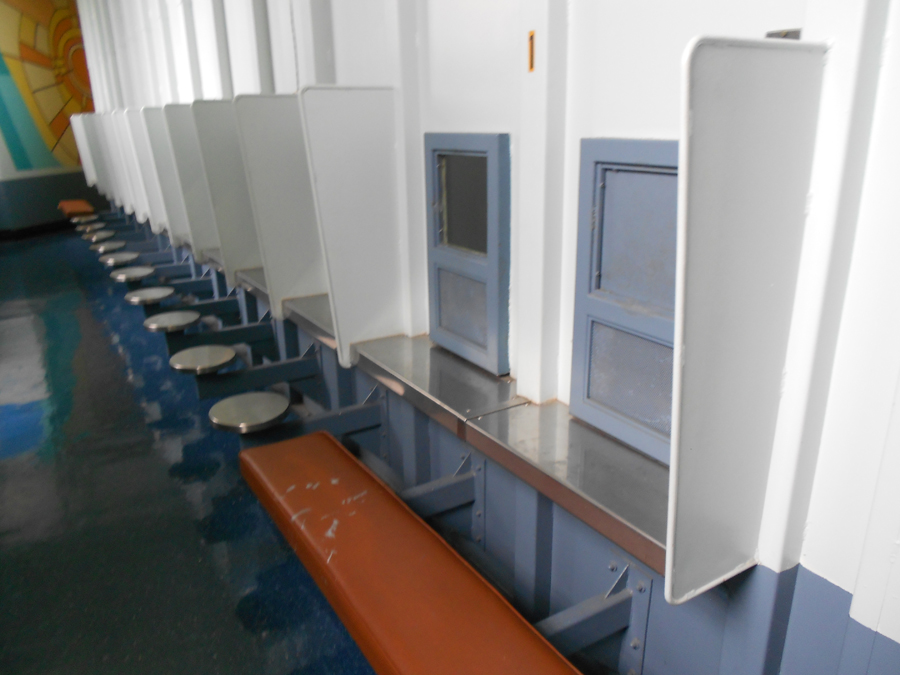 |
| Prisoners sat on one side
and visitors on the other. |
The tour includes most parts of the prison, including the
cafeteria, yards, and administrative and warden's building.
There is even a small chapel. The guide often adds
stories; there were prison breaks, riots, shankings, and all
aspects of prison life.
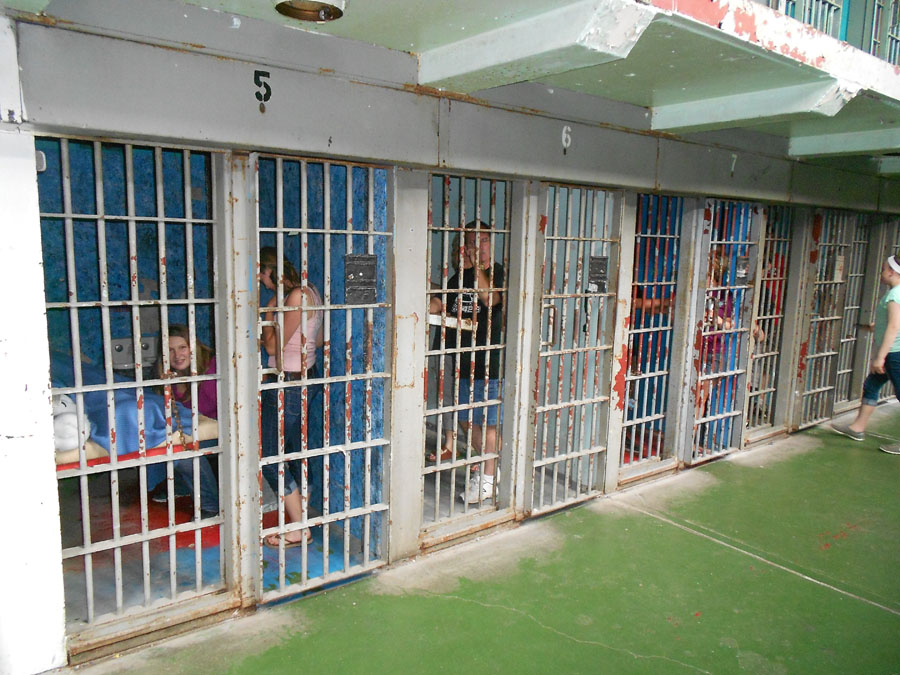 |
| Cells, with tourist "prisoners."
|
As the tour progresses, you start to realize how many
guards towers were scattered around the compound, many inside
the buildings. The
warden and his family had to live at the prison; an iron bar
revolving door separated them from the prisoners.
One stop is the "Wagon Gate" or main entrance for
vehicles. In the
center of the gate is a trapdoor that was used for hangings.
This was one once of the most violent prisons in the country and
the tour does nothing to help its reputation.
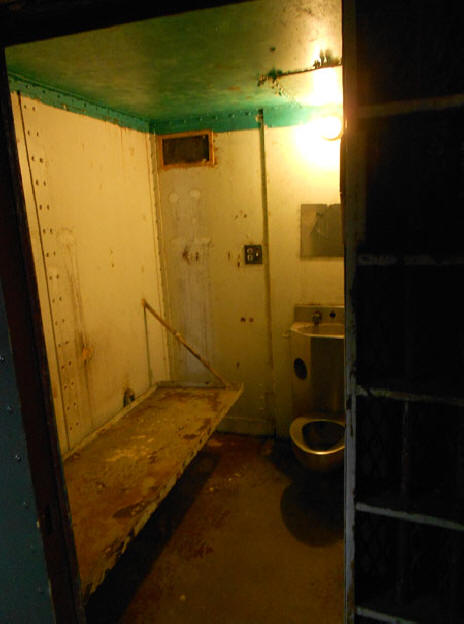 |
 |
| How would you like to spend a day
in here? |
"Stone wall do not a prison
make, nor iron bars
a cage," but they can be very
intimidating. |
For a different type of roadside attractions, Moundsville is
worth the stop. The mound and museum offers history and Native
American culture.
The prison tour will change your whole perspective on prison
movies and will even help to reduce any criminal motivations you
might have.
 |
| Prison yard. |
Author and Photographer:
Tom Straka is a forestry professor at Clemson University in
South Carolina. His wife, Pat, is a consulting forester. Both
have a keen interest in roadside history.
For more information:
Grave Creek Mound Archaeological Complex and Museum:
http://www.wvculture.org/museum/GraveCreekmod.html
Indians of the Midwest: Moundbuilders:
http://publications.newberry.org/indiansofthemidwest/people-places-time/eras/moundbuilders
West Virginia Penitentiary: Where History Meets Mystery:
http://www.wvpentours.com
Haunting Ghost Stores of West Virginia Penitentiary:
http://crime.about.com/od/prison/a/moundsvills.htm
|
![]() Ads fund American Roads so please consider them for your needed
purchases.
If you enjoy the articles we offer, donations
are always welcome.
Ads fund American Roads so please consider them for your needed
purchases.
If you enjoy the articles we offer, donations
are always welcome.
----------
|